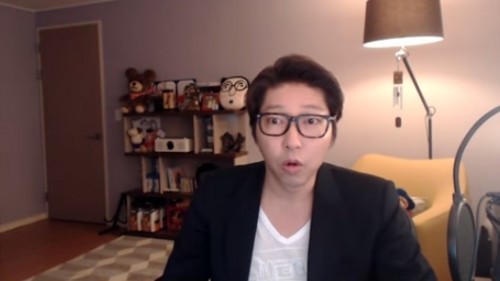Korean top streamer ditches AfreecaTV in favor of YouTube
Fast-growing streaming market at a crossroads as heavyweight streamers seek better profit-sharing deals
By Bak Se-hwanPublished : Oct. 18, 2016 - 17:48
South Korea’s top streamer, known as “Daedoseogwan” (‘Great Library’ in English), has left the country’s biggest video-sharing platform, AfreecaTV, over profit-sharing conflicts.
The 38-year-old streamer, whose real name is Na Dong-hyun, gained fame by streaming online game plays on AfreecaTV. Na has so far attracted 113 million viewers on AfreecaTV since 2011, emerging as one of the most sought-after streamers here. He also has 1.3 million YouTube subscribers.
The 38-year-old streamer, whose real name is Na Dong-hyun, gained fame by streaming online game plays on AfreecaTV. Na has so far attracted 113 million viewers on AfreecaTV since 2011, emerging as one of the most sought-after streamers here. He also has 1.3 million YouTube subscribers.

AfreecaTV, launched in 2005, relied heavily on influential streamers like Na to gain a growth momentum and seek profits in the fledgling streaming market. Their relations were, at least initially, amicable, as they needed each other to boost traffic and strengthen their brand.
As top-rated streamers can make bigger profits on the strength of their fans and corporate sponsors, they begin to question the cut in profit they pay to AfreecaTV. As the streaming industry expanded, their relationship started to show signs of strain.
The bubbling conflict exploded on Oct. 14 when AfreecaTV suspended Na’s broadcast channel for seven days, a punishment for conducting for-profit activities with a corporate advertiser without getting permission.
About a week earlier, Na co-hosted a live broadcast via AfreecaTV with his wife Lee Umi, another well-known streamer known as Yum-Dang to advertise a mobile game called “Acheron.” The broadcast also featured well-known Japanese gravure idol Ai Shinozaki, who has been recruited as the main model for the game.

Na and Lee did not get permission from AfreecaTV for the commercial broadcast, which resulted in the suspension. What angered Na was not a procedure for getting prior permission but the profit-sharing scheme that he views as unfairly favoring AfreecaTV.
“I don’t get their logic. I did the commercial, but somehow they tell me to share the revenue,” Na said on his YouTube channel last Friday. “That is why I’ve decided to move to YouTube. They don’t charge me for airing a commercial broadcast.”

Na claimed that AfreecaTV charges partner streamers up to 10 million won ($9,000) per each sponsored broadcast, and his agency, CJ E&M, an entertainment arm of CJ Group, has covered the fees.
AfreecaTV confirmed that there is indeed a profit-sharing plan, but refused to reveal how much streamers pay. Lee Dae-woo, PR manager at AfreeaTV, told The Korea Herald that the company is following the rules: “Whether it is for commercial broadcast or new content, we are working closely with streamers to make sure their content abides by guidelines from the Korea Communications Commission.”
In addition to corporate sponsorship, AfreecaTV offers another tool through which streamers make money with their videos: “star balloon,” a digital coin that viewers can buy and give to streamers as a gift.
When streamers exchange the cyber money for real cash, AfreecaTV takes a cut of 30 to 40 percent, depending on their popularity. There are only a small group of star streamers who earn a huge amount of money, so average streamers tend to search for alternative source of income with their videos.

YouTube offers such an alternative. Initially, the US video site was used as a free storage of video files after AfreecaTV streamers wrapped up their broadcast. On top of that, whenever their past videos are watched, they can get ad money from YouTube, which is not much.
A turning point came in August last year when YouTube kicked off Gaming, a new livestreaming channel. The service offers an alternate platform that could replace AfreecaTV, so Na seems to have made up his mind when he clashed with his longtime platform partner.
Moreover, other IT giants like Facebook and Twitter have also joined the streaming fray, allowing their users to stream content directly on their platforms.
A YouTube video that features Na playing Minecraft
“Great Library’s decision to move to YouTube may not be an isolated event,” an industry expert said. “Now with more platform options available, popular streamers here will see more incentives to look for a new place to maximize profits.”
Foreign streaming platforms such as YouTube and Twitch, however, are latecomers on the Korean market where AfreecaTV remains the dominant player. Their status might change if more top Korean streamers take cue from Na’s decision in search of better profit-sharing deals.
By Bak Se-hwan (sh@heraldcorp.com)


















![[Today’s K-pop] Treasure to publish magazine for debut anniversary](http://res.heraldm.com/phpwas/restmb_idxmake.php?idx=642&simg=/content/image/2024/07/26/20240726050551_0.jpg&u=)